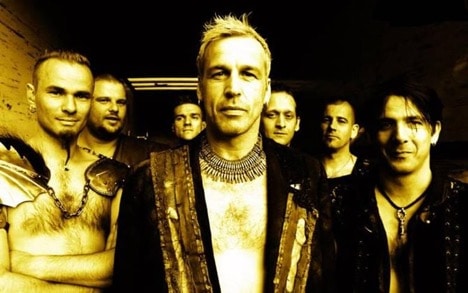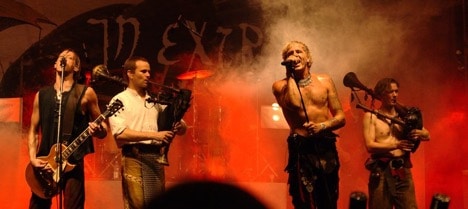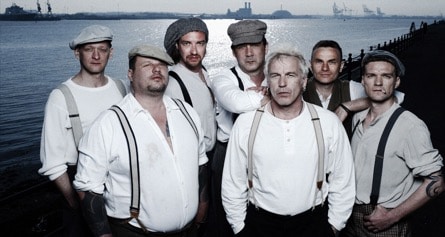The musicians of the group In Extremo are called the kings of the folk metal scene. Electric guitars in their hands sound simultaneously with hurdy-gurdies and bagpipes. And concerts turn into bright fair shows.
The history of the creation of the group In Extremo
The In Extremo group was created thanks to a combination of two teams. It happened in 1995 in Berlin.

Michael Robert Rein (Micha) (vocalist, founding member of In Extremo) had no musical education. But music has always been his passion. From the age of 13 he has already performed on stage. First, together with the Liederjan group, and then with other amateur groups.
In 1983, Rein created the rock group No. 13, which was not liked by the GDR authorities because of provocative lyrics that denigrated socialism. She even changed her name to Einschlag, but as a result, performances for her were banned. In 1988, Micha became part of the Noah collective.
Soon Kai Lutter, Thomas Mund and Rainer Morgenroth (bass player, guitarist, drummer of In Extremo) joined.
Ryan's second passion after rock was medieval music. From 1991, he performed at fairs and festivals, learned to play the bagpipe and shawl. Songs in ancient languages, colorful costumes and spectacular fire stunts inspired the musician to try to combine rock and folk. He inspired the rest of the band with his idea.
By the way, it was during the years of wandering around medieval festivals that Michael came up with the pseudonym Das Letzte Einhorn (The Last Unicorn). Music did not provide enough income, and he was forced to sell unicorn T-shirts.

Performances at fairs brought the Noah collective closer to other participants in the folk scene. Michael performed as a drummer with the band Corvus Corax and sang a duet with Teufel (Tanzwut).
In 1995, Mikha created his own folk group. The composition was inconsistent. In different periods it included: Conny Fuchs, Marco Zorzycki (Flex der Biegsame), Andre Strugala (Dr. Pymonte). Rine came up with the name In Extremo (translated from Latin means "on the edge"). He considered himself and the members of the team to be risky guys, so the name had to be chosen as extreme.
This year there were attempts to combine the sound of folk and rock together with the members of the Noah group. The first experiment was Ai Vis Lo Lop. This is a Provençal folk song in Old French written in the XNUMXth century. Her musicians tried to "weight". The result, according to the members of the group, turned out to be "terrible, but worthy of improvement."
Even then, the main and almost permanent composition of the In Extremo group was formed: Michael Rein, Thomas Mund, Kai Lutter, Rainer Morgenroth, Marco Zorzicki and Andre Strugal.

Early years: Die Goldene (1996), Hameln (1997)
In Extremo, although they were considered one group, they performed as two different teams. During the day at festivals and fairs, the medieval part was played, and at night, the heavy part. In 1996, the musicians worked on their first album, which included songs from two repertoires. At first, the record was untitled, but they decided to call it Die Goldene ("Golden") by the color of the cover.
But not only this influenced the official name. The album included 12 melodies adapted by musicians and performed on ancient instruments (shawls, bagpipes and cistre). The sources were the "golden" compositions of the medieval scene. For example, Villeman og Magnhild is a traditional Viking war song from the XNUMXth century. And Tourdion is a folk melody of the XNUMXth century.
The album was actually self-published. The musicians released it with their own money and sold it at festivals. March 29, 1997 at the Leipzig Fair, the first official concert of the group In Extremo of the combined repertoires took place. This moment became the band's birthday.
At one of the performances, the young band was liked by the Veilklang label representative. Thanks to him, the band wrote the Hameln album the following year. It had medieval melodies, almost no vocals. A year earlier, piper Boris Pfeiffer joined the group, and a new album was created with his participation.
The name of the record refers to the city of Hameln and the legend of the rat-catcher. The primary sources were Merseburger Zaubersprüche - a spell from the old German era, Vor vollen Schüsseln - a ballad by Francois Villon.
Then the image of the band members developed the way it is known now. The musicians performed in bright medieval costumes and arranged shows from their concerts - they spit fire, set off fireworks, performed acrobatic stunts. For this they liked the public. The clubs in which the group performed were always crowded. And there were a lot of people at the fairs.

The success of the group In Extremo
Just two months later, In Extremo released a new record, Weckt die Toten! The musicians recorded 12 tracks in 12 days - the producer from Veilklang hurried the group so much. The title of the album was chosen by chance almost before the release. One of Micah's friends appreciated the record that she, they say, "can wake up the dead."
Once again, ancient motifs and texts became the source of materials. The album contains songs based on XNUMXth-century poetry from the Carmina Burana collection of medieval poetry (Hiemali Tempore, Totus Floreo). The album included the famous Ai Vis Lo Lop and Palästinalied. This is a song about the Crusade, written by the famous Minnesinger poet Walter von Vogelweide in the XNUMXth century. The listeners liked the compositions so much that to this day they are considered one of the band's calling cards.
Weckt die Toten! turned out to be successful. The album was well received by critics, more than 10 thousand copies were sold in three weeks.
In parallel, the musicians released another acoustic album, Die Verrückten sind in der Stadt. Then they often traveled to fairs. The collection includes medieval melodies without vocals, with Michael's jokes and stories.
1999 was a difficult year for the band. At one of the performances, Miha received burns due to the misuse of pyrotechnics. The existence of the group was in jeopardy. But Ryan recovered in just a few months, and the group In Extremo continued to perform.
This incident slowed down the recording of the next album. But in the fall of 1999, the disc Verehrt und Angespien came out anyway. It included the songs that made In Extremo famous outside of Germany. For them, the group is loved, it is these hits that are performed at every concert. This is Herr Mannelig, an Old Swedish ballad written around the XNUMXth century.

Before the In Extremo team, it was performed by many groups, but the musicians were inspired by the version of the Swedes from the Garmarna team. For Spielmannsfluch, the primary source was a poem by the XNUMXth-century German poet Ludwig Uhland. The story of the king cursed by spiermans perfectly suited the image of vagabond musicians and quickly appealed to the public.
The album Verehrt und Angespien released This Corrosion, a cover version of the song Sisters of Mercy. For her, the group In Extremo shot the first video.
Critics received the new album with enthusiasm. The compilation album Verehrt und Angespien entered the German charts at number 11. This year the band changed its guitarist. Instead of Thomas Mund came Sebastian Oliver Lange, who has remained with the team to this day.
The arrival of world fame
The first 5 years of the new millennium became "golden" for the group. The In Extremo team toured Europe and South America, took part in major festivals. The musicians even became part of the Gothic computer game. In one of the locations they played their performance of Herr Mannelig.
In 2000, Sünder ohne Zügel (13 tracks) was released, which became the group's third album. It was he who set the style for the next two records.
Medieval motifs remained unchanged in it. The musicians again turned to Carmina Burana (Omnia Sol Temperat, Stetit Puella). And also to the songs of the peoples of Iceland (Krummavisur, Óskasteinar) and the work of Francois Villon (Vollmond). The second video of the group was later filmed for the last song. Until now, it has not lost its popularity; musicians perform it at every concert.
Three years later, the group recorded the album Sieben (“7.”) It became a new record, taking 3rd position in the charts in Germany, Austria and Switzerland. The name was not chosen by chance. There were always 7 musicians in the group. And the disc became the seventh in the discography (including live performances, released as a separate collection in 2002).
In the spring of 2005, the album Mein rasend Herz was released with 13 tracks. Working on it was difficult. Bassist Kai Lutter was living in Malaysia at the time, and the band had to exchange ideas over the internet. The title and the song of the same name in the album were presented to Michael (leader and inspirer of the group).
Three albums subsequently became "gold", that is, more than 100 thousand copies were sold.
In Extremo continued to tour and play festivals. The musicians sang at Wacken Open Air, the world's largest event for fans of heavy music. They also participated in the German Bundesvision competition with the single Liam and took an honorable 3rd place. Celebrating the 10th anniversary of the group, the musicians decided to re-release the first two records.
Also in 2006, the Kein Blick Zurück compilation was recorded. The "fans" were directly involved in it. They selected 13 of the best songs, which were released as a separate edition.

Change of musical direction
In 2008, with the release of the album Sängerkrieg, In Extremo decided to go for a heavy sound. Medieval texts were no longer in the repertoire, there were only two of them in the new disc. However, the album became the most successful in the history of the group. It held the 1st position in the charts for more than 30 weeks and went gold in just a year.
A music video was created for the song Frei Zu Sein.
The main song Sängerkrieg, which gave the name to the entire publication, became a kind of anthem for the group. It deals with the competition of spilmans - medieval musicians, which took place in the XNUMXth century. In Extremo compared themselves to them. Like real hairpins, they never “bowed down” to anyone and honestly did their job.
In 2010, the drummer changed in the group. Instead of Rainer Morgenroth came Florian Speckardt (Specki TD). The musicians celebrated 15 years of creative activity on a grand scale. The festival 15 Wahre Jahre was organized in Erfurt, to which well-known German bands were invited.
In the album Sterneneisen (2011), the medieval sound became even less. The music of the In Extremo group has changed in the direction of heaviness and rigidity. The texts from ancient manuscripts and folk songs were replaced by compositions of his own composition. 11 songs out of 12 were written by the band members themselves in German. But the sound of ancient instruments has not disappeared. The musicians still played the bagpipes, the harp and the hurdy-gurdy.
Like Sängerkrieg, the album was successful and stayed on the charts for 18 weeks, peaking at number 1. The tour in his support took place all over the world, including the USA, South America and the CIS countries.
New group stage
In 2013, the album Kunstraub was released. He was inspired by a story about a gallery robbery in Rotterdam. Thieves carried out paintings by famous Dutch masters, and the musicians adopted the images of adventurous art thieves. The design of their costumes and stage has changed, and so has the presentation of the group.
Kunstraub was the band's first German album In Extremo. Not a single song in another language was recorded for him. The public received the new album with mixed feelings, but the critics liked it.
In 2015, In Extremo celebrated their 20th anniversary. All of the band's albums have been re-released and compiled into a large collection of 20 Wahre Jahre. They also held a large-scale festival of the same name, which thundered in the city of Sankt Goarshausen for three days in a row.
Quid pro Quo was the last album released by the band to date. The exit was seriously prevented by a fire that happened at the recording studio. But then the musicians managed to save the instruments and equipment. Therefore, the disc was released on time - in the summer of 2016.
According to critics, the Quid pro Quo compilation turned out to be heavier than previous albums. However, the group partially returned to medieval motifs, performing texts in Old Estonian and Welsh. And also using ancient instruments (nikelharpu, shawl and thrumshait).
The clip created by the musicians in an unusual manner for Sternhagelvoll became a peculiar zest for the album. It was filmed on a 360-degree camera, and the viewer could rotate the image himself.
Current activities of the group In Extremo
The band continues to tour the world and perform at major festivals such as Rock am Ring and Mera Luna. In 2017, the musicians played as the opening act for the legendary band Kiss.
According to rumors, the group In Extremo is preparing for the release of a new record, but there is no official information about this yet.



